Because technology doesn't stand still
...
... and yet, with design foresight, most system components
have remained backward and forward compatible for several years, circumventing
the need for one to always purchase entirely new machines as technology
progressed ...
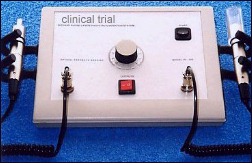 |
First Prototype - 1999
Before it would be named DermaWave, the original prototype was highly modular,
allowing us to load a variety of new, experimental circuit boards through
the bottom as we tweaked component parameters based on a series of clinical
trails for over a year. A centrally-mounted knob customized the unit for
different Fitzpatrick skin types - something only available on medical-grade
IPL units. The design, indeed, was originally intended for our exclusive
use - in our own Day Spa. It would be others who would strongly encourage
us to market it ....
|
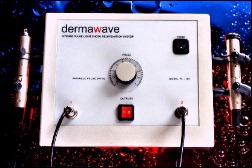 |
DermaWave PL-100: First Commercial Release -
2001
And with strong urging, our exclusive Spa device would hit the market. Now
named 'DermaWave' - Model PL-100, it carried over the same control knob from
our original prototype, allowing for continuously variable control -- unheard
of in an LED Photo Rejuvenation device. At the time, machines such as the
'Youth Light', DermaMaster 8000, et. al, were simply renamed "pain relief"
devices, masquerading as Photo-Rejuv units (only to be tragically copied,
over and over again, by yet others). The new DermaWave was, indeed, unique
- being designed from the ground-up as a true photorejuvenation device. Heads
were modular and readily interchangeable with a snap. It used no conventional
transformers in its power supply, allowing for an extremely low, slab profile
that sloped down to a thickness of only one-half of an inch. It premiered
at $4800 - about 40% less than anything else near its class at the time.
This liberty existed simply because we actually produced our own devices,
unlike others who had to purchase their machines, first, before they
could distribute them (much as it exists today).
|
 |
DermaWave PL-100: Revision II -
2002
This was the new revision that took all competitors by complete surprise.
Introduced only a year later, the new design pulsed at a staggering 64,000
times per second, with the control knob now regulating 'pulse width',
rather than pulse frequency. The heads grew in size, along with a whole new
system of heads that included the very first 'Green Beam' melanocyte-regulation
head by a U.S. maker. Along with this, a new 'Amber' head was introduced
as an option - several years ahead of its more current popularity among those
who later raced to catch up. Body Treatment heads were also introduced. In
total, it represented the most extensive head line in the industry. The 'Revision
II' also incorporated a new, Dynamic Feedback Loop in its circuitry that,
among other things, recognized a head's wavelength automatically - something
we wouldn't advertise or disclose at the time, not giving our competitors
a clue as to what would lay ahead ... But users would come to joyously
discover that future advancements could be plugged right in. No new machine
required.
|
 |
The DermaWave Petite - 2004
As a less expensive alternative to the PL-100 model, it was the
most compact professional system console to date (photographed with the Beatles'
'Abbey Road' CD, atop, to show its scale). Cross-compatible with all DermaWave
heads and accessories, it housed much of the same technology - as well as
the same output power - found in our larger unit. Our 'Dynamic Feedback'
circuitry would be revealed for the first time - though not yet fully
implemented. That would be unleashed for The Petite user later as new head
designs were being developed. Introduced at $3200, it became the most popular
model of all, to date ... and fast.
|
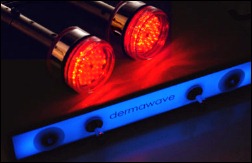 |
The DermaWave Atmosphere - 2006
A true landmark in Photo Rejuvenation - as well as for industrial design,
in general. Learning from the experience gained with the DermaWave Petite,
an entirely new unit stole the Las Vegas show. Yes, the heads got larger,
yet again ... but moreover, they contained new 'Photo-Optical' sensors that
read the skin type, much like a light meter, and adjusted the console
automatically - completely eliminating any control knobs. In addition, these
revolutionary new heads operated in the very same fashion with all previous
machines, right back to the PL-100, Revision II (which had secretly implemented
the Dynamic Feedback circuitry). All of this in something the same size as
The Petite ...with two heads.
Beyond this, many were highly enamoured of the trans-illuminated 'Blue Glow'
panel, from the aesthetic perspective. We further eventually came to know
that people were, in fact, additionally using the front of the machine
to treat 'Seasonal Affective Disorder'. Wow. ... Alas, from our perspective,
with its layered sandwiches of pristine Lucite, it was a very tedious and
time-consuming device to produce, with much hand-work in the production run.
But its look has now made it the only Spa device to ever achieve a quasi
"collectable status" among those in the know, who also recognized the
ground-breaking technology of The Atmosphere.
|
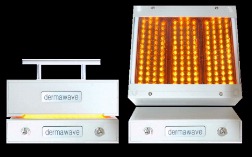 |
The DermaWave Cubic 7 - 2007
This is the interchangeable panel machine that had a GentleWaves representative
actually confront us at the Las Vegas show (a behavioral first),
proclaiming that, "We're (GentleWaves) the real one", then promptly
running off after executing this girlie bitch-slap in a cheap blazer. The
'real one', indeed. We were already working on the design of our third
machine when his company was still groveling for seed money from an attorney
and two Real Estate investors in Virginia Beach (Forbes Magazine / 2003)
... In the world of Photo Rejuvenation, they had - in fact - come late to
the table.
But there was good reason for his feeling of intimidation. The Planar-Paneled,
DermaWave Cubic 7 - at $3995 - packed more techno-punch than GentleWave units
costing several times more. And a variety of wavelengths were available -
not just one. It could even be configured with handpieces for those seeking
to buy-in even less expensively, expanding upward later on -- a configuration
known as 'The Pre'cis Format' ...
|
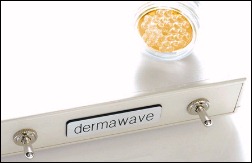 |
DermaWave Cubic 7: Pre'cis Format -
2007
And so it would be ... The Cubic 7 console, capable of powering four large
panel heads at once, offered in a package that instead mated it with our
Photo-Optical handpiece heads. And any could be turned in - for full value
- should one ever wish to upgrade to a large Planar panel head. The buy-in
price, with a 590nm head (or any other wavelength of one's choosing)... $2495.
The Cubic 7 module moved its four 'Smart Port' outputs to the sides and back
to provide an extremely clean industrial design look from the front. It also
would be incredibly easy to use. And it remained fully cross-compatible with
all DermaWave machines and heads that preceded it.
|
 |
DermaWave Cubic 5 - 2010
Realizing that people were spending more money on individual wand heads that
hooked up to simple transformers (like those found at Radio Shack), we developed
a true professional, modular, and open-architeture system for the up-start
Esthetician - or the one going out on their own. Measuring only 5 by 5 inches
when viewed from the top, it was a powerhouse - using a totally unconventional
power supply, along with much of its technology borrowed from the Cubic 7
series. At $1495 - with an AmRed photo rejuvenation wand head - it
was, and remains, jaw-dropping. It certainly was to some chief competitors
who soon bowed-out and ran to the home consumer market, instead. |
888 704 5888 |
|